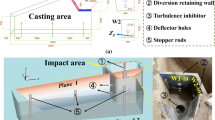Abstract
Indenter is one of the core components of a waste compression station. In this paper, a new layout free from the existing structure for indenter with lighter weight and good performance is presented. The design procedure includes two steps: Topology optimization and thickness optimization. In topology optimization process, a creative layout of indenter is obtained using Solid isotropic microstructures with penalization (SIMP) method. In thickness optimization process, based on topology optimization results, a design review was conducted, and a revised model was created which addresses all structural and manufacturability concerns. Shape and size optimization was then performed in the detailed design stage to further minimize the mass while meeting the stiffness and stress targets. Finally, an optimized model for the indenter is obtained. From the finite element analysis, it can be seen that there is a 31.8 % reduction in total mass while the performance increased compared with the original model.
Similar content being viewed by others
References
V. Shobeiri, Topology optimization using bi-direction at evolutionary structural optimization based on the elementfree Galerkin method, Optim Eng, 48 (2016) 380–396.
J. Z. Lin, Z. Luo and L. Y. Tong, A new multi-objective programming scheme for topology optimization of compliant mechanisms, Struct Multidiscip O, 40 (2010) 241–255.
J. G. Cho, J. S. Koo and H. S. Jung, A lightweight design approach for an EMU carbody using a material selection method and size optimization, J. of Mechanical Science and Technology, 30 (2016) 673–681.
J. Y. Lim, J. S. Kim, J. Kim and H. B. Smith, Dynamic effects on the lightweight design of metallic core sandwich columns, J. of Mechanical Science and Technology, 29 (2015) 1335–1340.
W. W. Zhang, X. S. Wang, Z. R. Wang and S. J. Yuan, Enhancing fatigue life of cylinder-crown integrated structure by optimizing dimension, Frontiers of Mechanical Eng., 10 (2015) 102–110.
X. Huang and Y. M. Xie, Optimal design of periodic structures using evolutionary topology optimization, Struct Multidiscip O, 36 (2008) 597–606.
C. J. Kim, Y. J. Kang, B. H. Lee and H. J. Ahn, Sensitivity analysis for reducing critical responses at the axle shaft of a lightweight vehicle, Int. J. Automot. Techn. (2012) 451–458.
K. S. Park and S. K. Youn, Topology optimization of shell structures using Adaptive inner-front (AIF) level set method, Struct Multidiscip O, 36 (2008) 43–58.
G. W. Jang, M. S. Yoon and J. H. Park, Lightweight flatbed trailer design by using topology and thickness optimization, Struct Multidiscip O, 41 (2009) 295–307.
X. H. Zhao, Y. X. Liu, L. Hua and H. J. Mao, Finite element analysis and topology optimization of a 12000 KN fine blanking press frame, Struct Multidiscip O, 54 (2016) 375–389.
M. P. Bendsøe and N. Kikuchi, Generating optimal topologies in structural design using a homogenization method, Computer Methods in Applied Mechanics & Engineering, 71 (1988) 197–224.
B. He, W. Tang, S. Huang, S. C. Hou and H. X. Cai, Towards low-carbon product architecture using structural optimization for lightweight, Int. J. Adv. Manuf. Tech., 83 (2016) 1419–1429.
W. Zhong, R. Y. Su, L. J. Gui and Z. J. Fan, Topology and sizing optimization of discrete structures using a cooperative co-evolutionary genetic algorithm with independent ground structures, Eng. Optimiz., 48 (2016) 911–932.
D. S. Kim and J. Lee, Structural design of a level-luffing crane through trajectory optimization and strength-based size optimization, Struct Multidiscip O, 51 (2015) 515–531.
C. S. Edwards, H. A. Kim and C. J. Budd, An evaluative study on ESO and SIMP for optimising a cantilever tie–beam, Struct Multidiscip O, 34 (2007) 403–414.
U. E. Ozturk, Efficient method for fatigue based shape optimization of the oil sump carrying a differential case in four wheel drive vehicles, Struct Multidiscip O, 44 (2011) 823–830.
Y. Liu, Y. Shi, Q. Zhou and R. Q. Xiu, A sequential sampling strategy to improve the global fidelity of metamodels in multi-level system design, Struct Multidiscip O, 53 (2016) 1295–1313.
J. Lilly and S. prakash, Experimental investigation and multiresponse genetic optimization of drilling parameters for self-healing GFRP, J. of Mechanical Science and Technology, 31 (2017) 3777–3785.
J. Herskovits, A. Leontiev, G. Dias and G. Santos, Contact shape optimization: A bilevel programming approach, Struct Multidiscip O, 20 (2000) 214–221.
J. Lan, J. W. Hu, C. P. Song, L. Hua and Y. M. Zhao, Modeling and optimization of a 10000 KN fine blanking press frame, RSETE (2012) 8353–8357.
D. L. Shu, Mechanical property of engineering material, China Machine Press, Beijing (Chinese) (2007).
M. P. Bendsøe, Optimal shape design as a material distribution problem, Struct Multidiscip O, 1 (1989) 193–202.
M. Stolpe and K. Svanberg, An alternative interpolation scheme for minimum compliance topology optimization, Struct Multidiscip O, 22 (2001) 116–124.
Y. M. Xie and G. P. Steven, A simple evolutionary procedure for structural optimization, Comput. Struct., 49 (1993) 885–896.
G. W. Jang, M. S. Yoon and J. H. Park, Lightweight flatbed trailer design by using topology and thickness optimization, Struct Multidiscip O, 41 (2009) 295–307.
Author information
Authors and Affiliations
Corresponding author
Additional information
Recommended by Associate Editor Gang-Won Jang
Ang Li obtained his B.S. and M.S. degrees from CUMTB. Now he is reading his Ph.D. in School of Mechatronic Engineering from China University of Mining and Technology. His research interests include lightweight structural design based topology optimization and fatigue prediction.
Rights and permissions
About this article
Cite this article
Li, A., Liu, C. & Feng, S. Topology and thickness optimization of an indenter under stress and stiffness constraints. J Mech Sci Technol 32, 211–222 (2018). https://doi.org/10.1007/s12206-017-1222-x
Received:
Revised:
Accepted:
Published:
Issue Date:
DOI: https://doi.org/10.1007/s12206-017-1222-x




